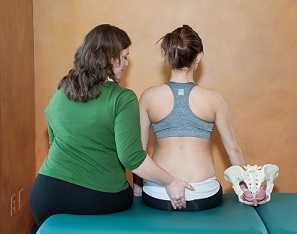Coccygeal Movement Test

Can palpation of the coccyx provide an objective screening tool to assess appropriate identification of pelvic floor muscles in patients? Researchers in the UK aimed to determine if external palpation of the coccyx bone would allow an examiner to evaluate pelvic floor muscle activity in women for functions of pelvic muscle contraction or bearing down/straining. Because the pelvic floor muscles, in particular the levator ani muscles, attach to the coccyx via thickened connective tissue, an effective lifting contraction of the pelvic floor muscles should create a flexion movement in a healthy coccyx or tailbone. Likewise, a bearing down may produce an extension movement of the coccyx palpable to a finger placed over the bony landmark.
In this study, 24 healthy women (whom the researchers knew could appropriately contract their pelvic floor muscles) volunteered to participate. The median age of the participants was 57 years old. Results of the study include that the researchers were able to correctly evaluate a contraction, bearing down, or resting position of the coccyx in 56/58 observed.The authors conclude that the coccygeal movement test, or CMT, can be a useful screening test for determining if a woman can appropriately locate and contract the pelvic floor muscles, or PFM. The CMT can be performed in a sitting position or with the subject in a side lying position. In the research study, subjects wore light clothing and were assessed in sitting. The tester placed the middle finger on or close to the coccyx. A correct contraction was considered one in which the coccyx flexed or moved inward. (The participant chose a notecard with the requested action- contract, relax, or neutral- that were shuffled, so that the investigator was blinded to the movement the subject would be completing during the assessment.)
The results of the study indicated that the coccygeal movement test was sensitive (could predict if the woman correctly located her pelvic floor muscles), but not specific (some of the women who could in fact locate the PFM were identified as not being able to locate them.) The authors do not suggest that this external screening test should replace vaginal palpation in women who may require pelvic floor muscle training. Rather, they offer that this simple, non-invasive screening test may provide a method for confirmation of a correct contraction in situations when women are instructed in preventive pelvic floor exercises, such as during prenatal visits. Because many women who are instructed to complete pelvic floor exercises are not offered objective confirmation of appropriate contractions, this test may serve as a middle ground for providers in environments when a quick screen is most appropriate. The authors do caution that the test may misidentify a woman as not being able to properly contract when in fact she is able to contract.
Examination and treatment skills for coccyx are included at length in the course Pelvic Floor Level 2A, in which both external and internal treatment skills are acquired. The next PF2A course is filling up quickly for its scheduled event in Wisconsin in March of next year. The Coccyx Pain: Evaluation & Treatment continuing education course created by faculty member Lila Abbate is back in 2015, a course entirely based on coccyx dysfunction and rehabilitation. The next opportunity to take Lila's course is in California in March.
By accepting you will be accessing a service provided by a third-party external to https://hermanwallace.com./








































